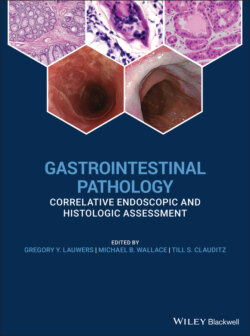Читать книгу Gastrointestinal Pathology - Группа авторов - Страница 57
Clinical Features and Endoscopic Characteristics
ОглавлениеThere are several endoscopic classifications of gastroesophageal reflux disease (Figure 2.9). The Los Angeles Classification divides esophagitis into four grades:
Grade A: one or more mucosal breaks, each no longer than 5 mm.
Grade B: at least one mucosal break more than 5 mm long, but not continuous between the tops of 2 mucosal folds.
Figure 2.9 Endoscopic appearance of erosive esophagitis in a patient with gastroesophageal reflux disease.
Grade C: at least one mucosal break that is continuous between the tops of 2 or more mucosal folds, but which is not circumferential.
Grade D: a circumferential mucosal break, erosions and ulceration, often resulting in scarring and stenosis if the reflux is recurrent.
Mucosal bridges and esophagogastric fistulae may be encountered.
The endoscopic findings in reflux esophagitis have been classified into three main stages: active, healing, and scarring. Relapse and healing occur repeatedly in patients with gastroesophageal reflux disease (GERD), and a mixture of the stages is often seen in biopsy specimens.
